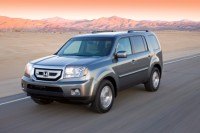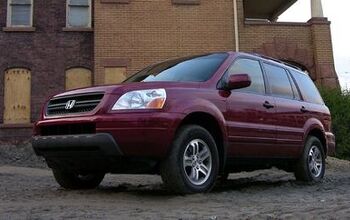2009 Honda Pilot EX-L Review, Take 2
Growing up, I thought the Porsche 911 was hideous. Its bug eyes and lumpy lines made me wonder if the designer had accidentally knocked modeling clay off his drafting table and submitted the splatter. This notion persisted until I drove one. Some 130 mph later, I considered the 911 the most beautiful automotive form on earth. Driving the all-new 2009 Honda Pilot EX-L kinda sorta triggered the same type of perceptual realignment. Call it Zen and the art of "challenging" design.
That's not to say I hated the new Pilot's looks at first glance. The effete minivan-ish look of the first generation CUV needed beefing-up more than an anorexic body-builder. So I was ready for something radical. And boy, did I get it. The new Pilot's grill "features" a thick chrome double-D rotated 90-degrees to the right; an affectation that's more Tranformers than transformative. The Pilot's rear end demonstrates the classic SUV refrigerator-on-wheels look, easily confused with the new Liberty (sans trapezoidal wheel wells). Taken as a whole, the new Pilot is like the big-boned girl that people can't decide whether she's an ugly duckling or the next "it" girl (I'm looking at you Scarlet Johansson).
The Pilot might not have turned out exactly as Honda's chief designer Dave Marek intended, but the look certainly projects greater solidity and presence than it's predecessor. Stylistically, the new Pilot harks back to a simpler time, when real men (and their wives) drove SUVs [kidding-ish]. If you think that the new Toyota Highlander looks like a contemporary example of Japanese design running awry of American taste, and that futuristic CUV's such as the Ford Edge and Mazda CX-9 look more at home on the cover of a Journey album than rolling around U.S. highways, they you'll find Pilot's masculine simplicity a step in the right direction. If not, not.
The Pilot's inner confines are free from the pseudo-luxury pretenses that afflict nearly every other car on the road. Aside from the cowhide pulled tight over seats and steering wheel, all surfaces are fashioned from easy-to-clean durable plastic. These are not brittle poor-quality polymers masquerading as chrome or wood, but proud durable materials that know that their primary role is to serve families with messy kids.
The Pilot's front seats are comfortable and supportive enough for non-track trekking. The second and third rows are little more than padded benches that fold flat. Kids are cool, but the Geneva Convention specifically prohibits adults from extended tours of duty. Parents that don't pony-up for the Touring Edition with satellite navigation still avoid smushed tikes and trikes via the Pilot's rearview backup camera, with a display conveniently located in the rear view mirror.
When I tested a Gen One Pilot about two months ago, I was shocked by how poorly it drove and handled. The crossover that once set the standard for SUV-driving dynamics had been thoroughly outclassed by the rest of the industry. Especially notable: the four-wheel independent suspension-equipped, front wheel-drive (FWD) trucklet's tendency to crab-walk its way over bumps.
The '09 Pilot's handling dynamics now boast contemporary car-like excellence. Soccer moms and suburban dads can now schlep kids to school, fetch groceries and commute to work without wrestling with the tiller. The base Pilot's tendency to torque steer, introduced when Honda deleted all wheel-drive (in pursuit of mpg), hasn't been eliminated. But drivers are now unlikely to push the engine above 4800 rpm, where the twist wreaked havoc with the FWD model's steering. By 5500 rpm, the power steering boosts to counteract the torque, and all steering feedback blacks out.
As you'd expect, Honda told their engineers to preserve the Pilot's performance while squeezing more fuel economy from the package. The '09 Pilot is powered by a new 3.5-Liter 24-Valve SOHC i-VTEC V-6 engine that's good for an adequate (i.e. faint praise) 250hp and 253 lb-ft torque. The minor power increase offsets the new truck's extra 84 lbs. (about two percent more), keeping the horsepower-to-weight ratio nearly identical to the outgoing model. In real world driving, anyone familiar with the old Pilots won't discern any difference.
The powerplant features Honda's improved Variable Cylinder Management system (previously only available on the FWD Pilots). While the resulting 17/22 mpg might make Civic drivers cringe, according to the fine folks at the EPA the system delivers up to seven percent better fuel economy in town and 10 percent on the highway. At the least the bump removes a psychological barrier for re-upping Pilots.
The Honda Pilot may not have hardcore towing or off-road ‘wheeling machine skills, but it can do both in a limited capacity. It's best to simply think of the Pilot as a slightly larger eight-passenger version of Honda's excellent CR-V. Rock solid. Safe. Unpretentious. Practical. Reliable. Zen for families that appreciate the finer points of basic transportation.
More by William C Montgomery
Latest Car Reviews
Read moreLatest Product Reviews
Read moreRecent Comments
- Alan Years ago Jack Baruth held a "competition" for a piece from the B&B on the oddest pickup story (or something like that). I think 5 people were awarded the prizes.I never received mine, something about being in Australia. If TTAC is global how do you offer prizes to those overseas or are we omitted on the sly from competing?In the end I lost significant respect for Baruth.
- Alan My view is there are good vehicles from most manufacturers that are worth looking at second hand.I can tell you I don't recommend anything from the Chrysler/Jeep/Fiat/etc gene pool. Toyotas are overly expensive second hand for what they offer, but they seem to be reliable enough.I have a friend who swears by secondhand Subarus and so far he seems to not have had too many issue.As Lou stated many utes, pickups and real SUVs (4x4) seem quite good.
- 28-Cars-Later So is there some kind of undiagnosed disease where every rando thinks their POS is actually valuable?83K miles Ok.new valve cover gasket.Eh, it happens with age. spark plugsOkay, we probably had to be kewl and put in aftermarket iridium plugs, because EVO.new catalytic converterUh, yeah that's bad at 80Kish. Auto tranny failing. From the ad: the SST fails in one of the following ways:Clutch slip has turned into; multiple codes being thrown, shifting a gear or 2 in manual mode (2-3 or 2-4), and limp mode.Codes include: P2733 P2809 P183D P1871Ok that's really bad. So between this and the cat it suggests to me someone jacked up the car real good hooning it, because EVO, and since its not a Toyota it doesn't respond well to hard abuse over time.$20,000, what? Pesos? Zimbabwe Dollars?Try $2,000 USD pal. You're fracked dude, park it in da hood and leave the keys in it.BONUS: Comment in the ad: GLWS but I highly doubt you get any action on this car what so ever at that price with the SST on its way out. That trans can be $10k + to repair.
- 28-Cars-Later Actually Honda seems to have a brilliant mid to long term strategy which I can sum up in one word: tariffs.-BEV sales wane in the US, however they will sell in Europe (and sales will probably increase in Canada depending on how their government proceeds). -The EU Politburo and Canada concluded a trade treaty in 2017, and as of 2024 99% of all tariffs have been eliminated.-Trump in 2018 threatened a 25% tariff on European imported cars in the US and such rhetoric would likely come again should there be an actual election. -By building in Canada, product can still be sold in the US tariff free though USMCA/NAFTA II but it should allow Honda tariff free access to European markets.-However if the product were built in Marysville it could end up subject to tit-for-tat tariff depending on which junta is running the US in 2025. -Profitability on BEV has already been a variable to put it mildly, but to take on a 25% tariff to all of your product effectively shuts you out of that market.
- Lou_BC Actuality a very reasonable question.






































Comments
Join the conversation
I have a 2007 Honda Pilot and would like to trade it in for something newer. Based on the 2007, I don't think that I would consider another Pilot. While I know that Hondas are reliable and I have had no problems with it, I am very dissapointed in how noisy it is. The road noise on the highway is awful. The air-conditioner sounds like a jet engine and you cannot carry on a conversation while its running. I hate the air vents on the console - there's no way to close the middle ones, only the side ones. The display on the radio/clock is impossible to see when wearing sun glasses.
I own a 2009 Honda Pilot (automatic transmission) from Repokar car auction. The 1.8 Liter engine is the center piece of this car. While cruising on the highway, the engine is composed and fuel efficient. So, it is literally a two-faced engine that can be both fun or economical. The transmission will stay smooth as long as you change the fluid on schedule (every 30k miles)But in rest it is very well performed and I like driving it)))